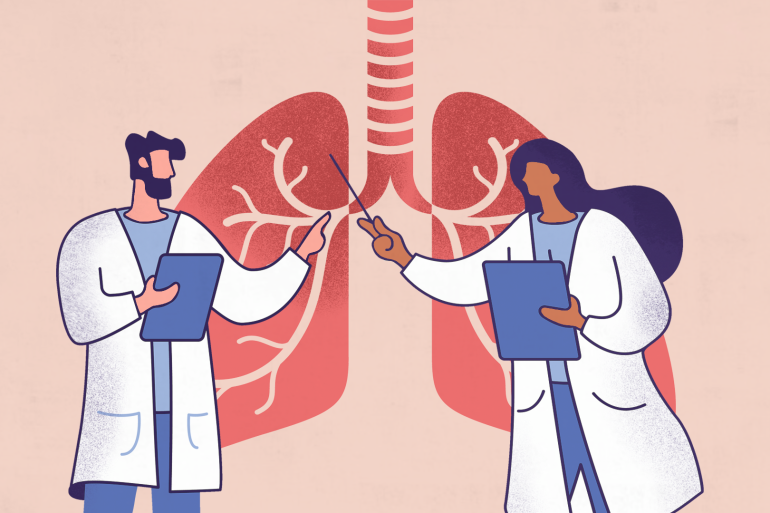Scientists are using the word “milder” with much trepidation to describe the illness conferred by the Omicron variant of SARS-Cov-2. It is widely accepted that even if the variant is milder, the sheer number of people it infects might lead to more hospitalisations overall, with healthcare workers having to isolate due to testing positive.
Real-world data is still coming in about whether or not this variant does indeed cause a milder illness and carries a lower risk of hospitalisation, but early laboratory data on lung tissue in mice and hamsters may hold some of the answers.
We already know that the Omicron variant harbours mutations that make it more transmissible. A team of researchers at Hong Kong University’s faculty of medicine found Omicron replicates 70 times faster than Delta in human airways. The study, which is yet to be peer-reviewed, showed that when compared with both Delta and the original coronavirus, the Omicron variant was much quicker at getting into the bronchus or tubes that run through the upper airways and lungs but much slower at infiltrating the lung tissue itself. According to the researchers, the Omicron variant replicated less efficiently, more than 10 times lower, once inside the human lung tissue than the original SARS-CoV-2 virus, which may suggest lower severity of disease.
It is hypothesised that serious illness from COVID-19 occurs once the virus gets into the lungs and spreads to other parts of the body from there, if it can be contained in the upper airways, the mouth, nose, etc, there is much less chance of severe disease.
However, the lead author Dr Michael Chan has urged caution over the findings. “It is important to note that the severity of disease in humans is not determined only by virus replication but also by the host immune response to the infection,” said Dr Chan.
Many of the COVID-19 hospitalisations have occurred not only because of the illness the virus causes but also because of the unpredictable nature by which our immune systems respond to the virus. In some cases, the immune system is unable to switch off and attacks not only the cells infected by the virus but the healthy cells, as well. Chan noted that a highly contagious virus like Omicron may cause more severe disease and death simply by spreading much faster, even though the associated lung infection appears not as bad.
A team studying the Omicron variant in Glasgow think they have found the answer as to why this variant is unable to infect the lung cells as much as it does the upper airways. They found an essential protein found on lung cells called TMPRSS2, which usually helped previous SARS-COV-2 variants to gain entry into the lung cells themselves bound less strongly to Omicron, meaning it was more difficult for this variant to get inside and infect lung cells.
The virus enters the cells lining the nose, throat and upper airways in a different way, so although it was found in high quantities in these parts of the airways, the concentration of the virus was lower in lung tissue. This might also partly explain why the Omicron variant is so transmissible, if it is concentrated in high quantities in the upper airways, viruses are more likely to be coughed, sneezed or breathed out from these parts of the airways and infect other people.
A combined American and Japanese study, which is still under peer review, looked at the effects of the Omicron variant in mice and hamsters. These rodents had the same ACE2 receptors that humans have and what the coronovairus binds to in order to enter and infect cells. The study found the rodents that were infected with Omicron had less lung damage, lost less weight and were less likely to die than those infected with Delta.
The studies offer some hope for a milder illness, but laboratory studies do not always translate into real-world data where more variables are involved. Data from South Africa, where the variant was first identified, continues to show no real increase in hospitalisations, but it is important to note that South Africa has a relatively young population. We are yet to see how the Omicron variant behaves in older people, indoor mixing during the Christmas and New Year period is likely to answer that question soon. It is also worth noting that schools across the world have been closed for the festive period but are due to open at the start of January, so children who have been drivers of infection in past waves will be exposed to the virus in classrooms and take it home to their families.
The UK has already started to see a sharp increase in hospitalisations due to coronavirus. The other sinister concern is Long COVID, when symptoms persist long after the virus has been cleared. And with so many people being infected with Omicron, we are likely to see more people affected by Long COVID.
As a doctor, I worry the implications of a milder illness may lull people into a false sense of security, perhaps make them less likely to wear a mask, socially distance or worse, take up the vaccine. We have become somewhat numb to the number of deaths from COVID-19. Milder or not, Omicron remains a serious global threat.
This article originally appeared in Al Jazeera as doctor's note.
The author, Dr Amir Khan is an NHS doctor and Senior Lecturer at The University of Leeds School of Medicine and The University of Bradford in the UK.











-20240507143830.jpg)






-cannot-influence-the-upazila-parishad-elections-(1)-20240507121623.jpg)




















